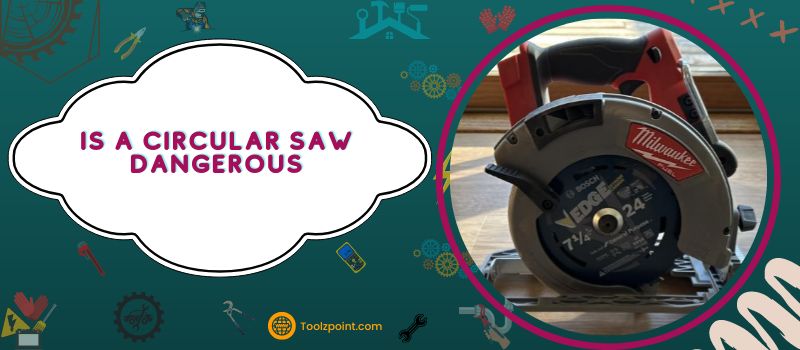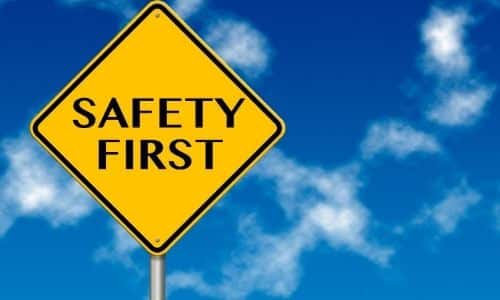If a workstation has a hundred tools, a circular saw will be one of them. If a workstation has ten tools, a circular saw will be one of them. If a workstation has one tool, you guessed it right, a circular saw will be the one.
Despite its powerful and versatile attributes, a circular saw imposes several risks and dangers such as cuts and amputations, kickbacks, electrical hazards, flying sawdust and debris, and so on.
Although a circular saw has its fair share of risks, you can avoid all or most of them by following some simple rules and guidelines. Let’s discuss it all out and out in this article.

Risks Generated Via A Circular Saw
A circular saw can pose threads in different ways. Most people concise their idea of risk using a circular saw on the blade alone. Although the blade is the riskiest hazard, there are other dangers that a circular saw can impose. Let’s find out the risks of using a circular saw.
1. Blade-Imposed Accidents
A circular saw blade, even when it is turned off is a health risk. The blade is so sharp and edgy that it can cut your skin very easily. So, imagine the risk when that blade is in motion. It can affect your body in the worst way possible. In the worst-case scenario, the blade can cause amputations of any body parts.
2. Kickbacks
Kickbacks are very common when you are using a circular saw. when the blade can’t penetrate smoothly into the material and faces any hindrance, you will feel counteracting force towards your arms. This can prove fatal if the force is too powerful and high.
3. Respirational Hazards
A huge drawback of the circular saw is that it generates a high quantity of sawdust. This might seem harmless as the sawdust exhales far away from the face. However, the flying sawdust can penetrate your respiratory system and lung posing serious health hazards. This becomes more gruesome when the particles contain any toxic elements.
4. Hearing Issues
The mechanics of a circular saw are very complicated and hence they produce extreme levels of loud and screeching noise. There are ways to make a circular saw quiet. However, those falls are insufficient in the long run when you keep using the circular saw on a regular basis.
5. Electrical Mishap
As a circular saw is a heavy and powerful tool it requires high power of energy to function. On average, a circular saw runs on 15 amps to operate. Such dependency on electricity can levy dangerous injuries to the user, especially if the circular saw is closer to expiration or the cord is damaged.
6. Fire Incidents
The metallic blade of a circular saw, contacted with highly dense material creates an intensity and tension. Such tension can create sparks and initiate fire incidents. The risk is even higher when the material is highly flammable, or the blade is not carbide-tipped.
7. Eye Injuries
This might not be a primary risk, but eye injuries are very common to the users of a circular saw, especially when they are not wearing safety goggles. Sawdust, debris, chips, and scraps can fly into the eyes and harm them or temporarily permanently.
Preventing The Potential Risks Of Using A Circular Saw
Do not feel discouraged about all that list of risks and dangers. Like everything in life, you can have solutions for all the risks imposed by a circular saw. But instead of waiting for the problem and then jumping to the solution, let’s see how we can prevent the problems from occurring.
1. Go Through The User Manual
I understand your excitement about getting a new circular saw and how desperate you are to try it. But frankly, I think you should read the manual and try to understand the tool first. Every model is unique, and the manual can hook you up with some important information about safety and user guides.
2. Say Yes To Protective Gears
No matter how novice or advanced you are, you should never neglect the protective and safety gear. You won’t have to wrap construction-based heavy suits but gloves,safety goggles, or glass and noise-canceling devices will suffice. When you are working, you should wear a full-sleeve shirt to cover the body.
3. Make The Right Call For The Blade
Since circular saws are not limited to one or two blades, you might feel confused about which blade will be suitable for a particular material. But quick research can let you know all about the blade and you can avoid tons of risk by making the right call about it. Moreover, it is equally important to ensure the use of sharp and non-blunt blades to avoid kickbacks.
4. Clamp The Material
Often it is seen that the material you are cutting with a circular saw has fallen from the workstation. This happens when users don’t pay heed to securing the material to the table. Since the circular saw creates a huge force when it is in motion, you need to clamp the material so that it can withstand that force.
5. Keep Your Hand At A Safe Distance
Wearing a glove will not be enough if the hand somehow gets caught on the blade. So, keep the hand where it is intended to be. If the circular saw is one-handed, keep the other hand on the edge of the material. Also, when the blade is on the end of the cutline, use a push stick, not your hand.
6. Avoid The Knots And Nails
The material you are cutting should be free from any hindrance. A knot, pins, or nails can divert the route of the blade. This will distract your hand from the cutline. Sometimes, it may lead to injury and cause kickbacks.
7. Keep The Circular Saw Safe When Not In Use
When you are done using the circular saw, it should be kept in a safe place, preferably in a box. The blade should at all times be covered with the blade cap. Make sure the saw is switched off. You should take the battery off a cordless circular saw. this way the risk will be minimized, and the battery will not run out.
Some Tips To Remember

- Use a circular saw with a dust collection system. This way you can be protected from flying sawdust and debris. However, make sure to clean the saw when the dust is filled.
- Keep the blade steady and properly aligned with the material. A blade’s correct placement ensures lesser kickbacks and longevity of the blade.
- A blunt blade is more dangerous than a sharp blade. You should check the blade’s quality frequently so that it stays put in integrity.
- When you are cutting a newer and unfamiliar material for the first time, practice cutting on a scrap of that material. This way you will get a grip on the handling of the saw without wasting a good panel.
People Also Ask

How to set the blade in proper alignment?
Every circular saw has a bevel adjustment. It aids you in tilting the blade at a certain angle. Setting the bevel and the depth in accordance with the material will ensure a proper alignment. You can manually check the alignment with a help of a straight edge.
Can I sharpen a blunt blade?
Theoretically, it is possible to sharpen a blunt blade, but it is not advocated. The toil and labor you have to put in to sharpen the blade is simply not worth it. It would be much easier to replace the old blade and get a new one.
How to reduce kickbacks in a circular saw?
Kickbacks are normal but that doesn’t mean you have no choice but to endure them. The best way to reduce the kickback is to use the proper blade on the proper material. When the tension between the material and the blade is lined up, you will automatically experience fewer kickbacks. Also, the adjustment and alignment of the blade play a role in reducing kickbacks.
Final Words
Every tool will have its pros and cons. It doesn’t mean you should deter yourself from using them. It means you have to learn about the cons and dangers and conquer them like a champ. The versatility and the value of a circular saw are unparalleled. So, instead of avoiding it and thinking about the dangers, you should think about ways of preventing those risks.
